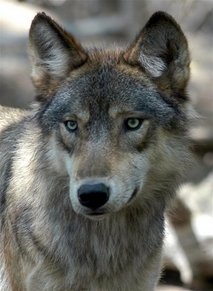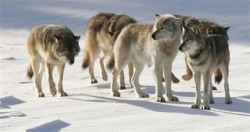Great Lakes Wolves returning to endangered list

The decision came less than two months after the U.S. Fish and Wildlife Service discontinued federal protection for about 4,000 wolves in Michigan, Minnesota and Wisconsin. The agency acknowledged Monday that it erred by not holding a legally required public comment period before taking action.
Under a settlement with five environmental and animal protection groups that had sued the agency earlier this month, the Fish and Wildlife Service said it would return Great Lakes wolves to the list while considering its next move. They had been classified as endangered from 1974 until their removal May 4.
About 1,300 wolves in Montana and Idaho also were dropped from the list then. Because a public comment period was held in their case, they are not covered by the deal announced Monday and their status will not change. A separate lawsuit on that case will move forward.
About 300 wolves in Wyoming remain listed.
U.S. District Judge Paul Friedman in Washington, D.C., must approve the settlement for it to take effect. If the Fish and Wildlife Service tries again to remove the wolves from the endangered list, it will hold a 60-day comment period, the settlement says.
The agency still believes "wolves in the western Great Lakes have met the recovery criteria and don't need to be listed," Georgia Parham, spokeswoman for the Fish and Wildlife Service, said.
Parham said federal officials had thought a comment period was not required because one had been held for a previous effort to reclassify the wolves. But they now agree another was needed, she said.
The activist groups that sued, including the Humane Society of the United States, say state plans for dealing with the wolves open the door to future hunting and trapping of the animals.
"This agreement will give the administration a much-needed opportunity to reconsider the failed wolf-management policies of the past, and hopefully put to rest the states' reckless plans to start sport hunting and trapping imperiled wolves," said Jonathan Lovvorn, a vice president of the Humane Society.
Michigan, Minnesota and Wisconsin contend their management plans will allow the species to continue flourishing.
The states recently have allowed people to kill wolves attacking livestock or pets. Those provisions would be nullified once wolves again are classified as endangered.
Gray wolves were listed as endangered in 1974, after they had been wiped out across most of the lower 48 states in the early 20th century by hunting and government-sponsored poisoning.
Thanks to federal protection and changing attitudes, they've come back strongly in the western Great Lakes over the past two decades. Minnesota's estimated population is 2,922; Michigan's is 580; and Wisconsin's, 626.
The federal government has tried six times in the past five years to drop them from the endangered list but has been thwarted by lawsuits.
Full Story:
http://news.yahoo.com/s/ap/20090630/ap_on_re_us/us_gray_wolf_endangered
Wolves no longer protected in northern Rockies

FOR THE WHOLE STORY: PLEASE VISIT THE SITE -------> http://news.yahoo.com/s/ap/20090504/ap_on_re_us/us_wolves_recovered;_ylt=AvFxSDKt2BRJnr3TAOjj0Nl4hMgF (copy and paste into address bar.)
By MATTHEW BROWN, Associated Press Writer Matthew Brown, Associated Press Writer – Mon May 4, 8:46 am ET BILLINGS, Mont. – Wolves in parts of the northern Rockies and the Great Lakes region come off the endangered species list on Monday, opening them to public hunts in some states for the first time in decades.
Federal officials say the population of gray wolves in those areas has recovered and is large enough to survive on its own. The animals were listed as endangered in 1974, after they had been wiped out across the lower 48 states by hunting and government-sponsored poisoning.
"We've exceeded our recovery goals for nine consecutive years, and we fully expect those trends will continue," said Seth Willey, regional recovery coordinator for the U.S. Fish and Wildlife Service in Denver.
With the delisting, state wildlife agencies will have full control over the animals. States such as Idaho and Montana plan to resume hunting the animals this fall, but no hunting has been proposed in the Great Lakes region.
Ranchers and livestock groups, particularly in the Rockies, have pushed to strip the endangered status in hopes that hunting will keep the population in check.
About 300 wolves in Wyoming will remain on the list because the U.S. Fish and Wildlife Service rejected the state's plan for a "predator zone" where wolves could be shot on sight. Wyoming Gov. Dave Freudenthal and a coalition of livestock and hunting groups have announced a lawsuit against the federal government over the decision.
Freudenthal, a Democrat, claimed "political expediency" was behind the rejection of his state's wolf plan.
Wolves were taken off the endangered list in the northern Rockies — including Wyoming — for about five months last year. After environmentalists sued, a federal judge in Montana restored the protections and cited Wyoming's predator zone as a main reason. In the Great Lakes, the animal was off the list beginning in 2007 until a judge in Washington last September ordered them protected again.
Environmental and animal rights groups have also said they planned to sue over the delisting, claiming that there are still not enough wolves to guarantee their survival. The groups point to Idaho's plan to kill up to 100 wolves believed to have killed elk.
"We understand that hunting is part of wildlife policy in the West," said Anne Carlson with the Western Wolf Coalition. "(But) wolves should be managed like native wildlife and not as pests to be exterminated."
The delisting review began under the administration of President George W. Bush and the proposal was upheld by President Barack Obama's administration after an internal review. In a recent letter to several members of Congress, Interior Secretary Ken Salazar wrote that he was "confident that science justifies the delisting of the gray wolf."
Willey said his agency projected there would be between 973 and 1302 wolves in the northern Rockies under state management, a number well above the 300 wolves set as the original benchmark for the animal's recovery.
More than 1,300 wolves roam the mountains of Montana and Idaho and an estimated 4,000 live in Michigan, Wisconsin and Minnesota.
FILE - In this Feb. 10, 2006 file photo released by Michigan Technological University, a pack of gray wolves is shown on Isle Royale National Park in northern Michigan. Wolves in parts of the Northern Rockies and the Great Lakes region are coming off the endangered species list, but several prior attempts to remove protections for the predators have been rejected by judges and new legal challenges are certain.
(AP Photo/Michigan Technological University, John Vucetich)
Arctic Council snubs EU as observer over seal dispute

TROMSOE, Norway (AFP) – The Arctic Council on Wednesday snubbed the EU, China, Italy and South Korea in their bid to become permanent observers on the council due to a row between Canada and the EU over the seal hunt.
In a final declaration issued after the Arctic Council's ministerial meeting in the northern Norwegian town of Tromsoe, the eight members of the body "decided to continue discussing the role of observers in the Arctic Council."
The seal hunt, an issue of particular importance to Canada, weighed heavily in the talks, members of several delegations said.
The 27 member states of the European Union are preparing to ban products derived from the commercial seal hunt, especially furs, to protest against hunting methods which they consider cruel.
The European Parliament is expected to vote on the ban in early May.
"Some European institutions have shown a lack of understanding with respect to the fundamental interests of Arctic people and states," Canadian Foreign Minister Lawrence Cannon told delegates Wednesday.
"I very much regret, therefore, that the European Parliament and Council (of European ministers) are currently considering an EU-wide ban on trade in seal products," he said.
"It is particularly disappointing that such a ban is being pursued despite clear evidence that the hunting of seals in Canada is sustainable, humane and well managed," he said.
The Arctic Council is the only regional cooperation body in the Arctic, founded in 1996 and made up of eight members: Canada, Denmark, Finland, Iceland, Norway, Russia, Sweden and the United States.
Britain, France, the Netherlands, Poland and Spain are permanent observers, while China, Italy, the EU and South Korea are ad hoc observers, meaning their presence at each meeting must be approved by member states.
The next council meeting is due in 2011 in Denmark.
Canada and Norway have threatened to submit complaints to the World Trade Organisation if the EU bans the import of seal-related products.
"Norway shares that view with Canada. But for Norway, that's yet another reason to invite the observers in," Norwegian Foreign Minister Jonas Gahr Stoere said.
Canada is the biggest seal-hunting country with a quota of 338,000 this year. Norway has authorised the killing of 47,000 adult seals in 2009.
Greenland, Iceland, Namibia, Russia and the United States also hunt seals.
